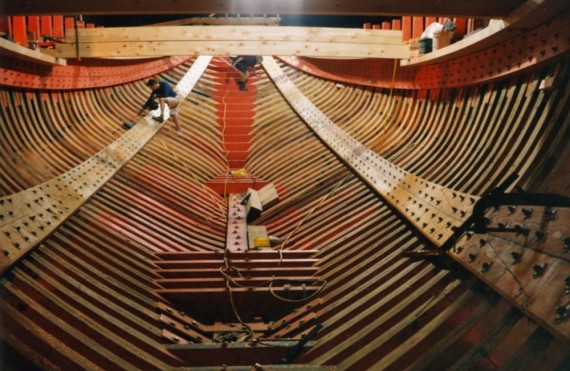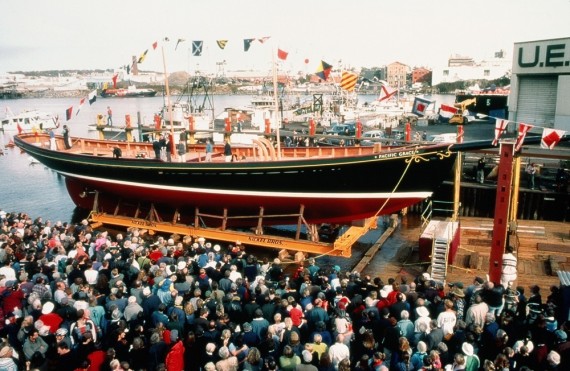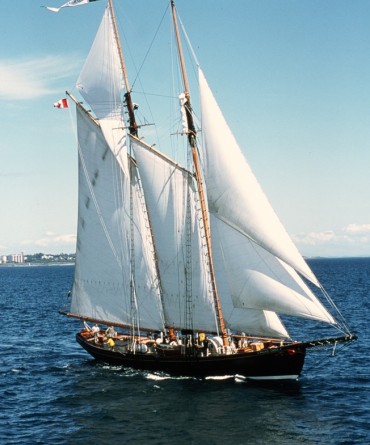Pacific Grace
1995-2001 Pacific Grace, a Robertson II Replica
| The launch of the new schooner, Pacific Grace, was just about the most moving and inspiring occasion I’ve experienced in five years as editor of Pacific Yachting. |
| Duart Snow, Editor, Pacific Yachting Dec. 1999 Issue |
| Because the drawings for the Robbie had been lost, Sidney naval architect Paul Gartside took the lines off the schooner and drew up detailed construction plans. SALTS appointed Tony Anderson, who had joined the organization as a volunteer in 1982 at the age of 18, to serve as project manager and head shipwright. Anderson merged his life with SALTS. His love of connecting young people with our maritime heritage motivated him to obtain his master’s ticket, help build two ships, skipper sail training cruises during the summer, and captain offshore voyages to the Galapagos, Pitcairn Island, French Polynesia and Hawaii and Expo ’92 in Seville Spain. |
 |
The burly shipwright and father of six sports an ample, biblical looking red beard. Five days before launch day, and despite numerous last-minute tasks, he appeared calm and relaxed. But there was no mistaking his passion for SALTS’ mission and for Pacific Grace.
The Grace is built of Nimpkish Valley Douglas fir. The 8” square deck-support beams are yellow cedar. The caprails and sole (flooring below deck) is hard-wearing purple heart from South America. SALTS built Pacific Grace for longevity. Grand Banks schooners were once built to last only 10-20 years, but the Robbie had lasted 67 years. Volunteer Bill Cox, who helped build the Robbie in 1940, explained: “The reason the Robbie lasted longer is that, during construction the military pulled the crew off the job and during their absence, the schooner’s green wood had a chance to dry.”
| Building Pacific Grace required careful planning and years of painstaking work. In the boatshed, a team of four shipwrights built a 90' x 30' white lofting floor and laser-leveled it to within 1/16". Next, they scaled up Gartside's line drawings to make full-size drawings on the lofting floor. After the lofting floor was dismantled, the backbone---two pieces of fir 40' long, 13" deep and 11' wide---was laid first. Anderson used modern "technology" to make patterns for the 63 double frames. Instead of wood, he used a clear mylar sheet to trace the construction drawings with coloured felt pens. The mylar patterns were then lain on huge billets of timber. "We used cranes and rollers to move the wood," explained Anderson. |  |
 |
"The mylar patterns worked very well. They saved us lots of time, were exact and lightweight. It's amazing that all the frame patterns can be stored in a four foot box." The team used a ship's head saw to bevel each frame to fit the hull curvature. Next, a mirror image of each frame was made; the "doubles" were bolted together, resulting in a thickness of 8", and these were secured to the backbone. After all the standing ribs were installed, they were faired lightly, and hull planks were fastened to the frames with galvanized lag bolts. The lag holes were plugged, and the hull faired again with electric hand planers, followed by board sanding above the waterline. The crew caulked the seams with cotton & oakum sealed with red lead paint. Seam compound finished the job. Pacific Grace's 3" hull and deck planks are prime Douglas fir, seasoned, knot-free and supplied by TF Specialty Sawmill, a company that also provides Japanese temple builders with timber. Anderson was pleased to have secured such long timbers that the 108' deck needed only 15 butts. The whole deck is bolted stem to stern through the carlins to keep it in compression and prevent sagging. |
Some statistics: 80,000 board feet make up the hull; the old-growth deck timbers have up to 45 grains per inch; the internal ballast consists of 42 tonnes of lead encased in concrete; the bowsprit is 30' long and 16" in diameter; the 18" diameter masts rise 120' above the waterline. Fully rigged, Pacific Grace carries about six miles of cordage. Steel strapping reinforces the hull, and diagonal wooden strapping stiffens the deck around the masts. Unlike the Robbie, the decking and stanchions of Pacific Grace cover the tops of the frames, protecting them from standing freshwater and preventing rot. "From restoring Robbie, we learned all the things that can damage a ship over time."
| It's a unique experience to be aboard our schooners. We attract youngsters from wealthy homes as well as from the streets. They cooperate and learn teamwork. The boat only goes if they work together. Yet they have freedom to be themselves. They learn that people will like them when they are themselves. These kids are away from all their usual things and habits. Instead, we expose them to a new world, a natural environment and new ideas. |
| Tony Anderson, Head Shipwright |
The "kids" are the raison d'etre for all this activity: the motivation for a crew of shipwrights to work five winters on a craft which some think represents obsolete technology; the reason 1,000 volunteers have donated countless hours; and the incentive for many more thousands to donate money. The SALTS ships provide "training, by the sea, for life"!
Pacific Grace section based on updated extracts from Pacific Yachting feature article: The Birth of Pacific Grace, January 2000, by Marianne Scott